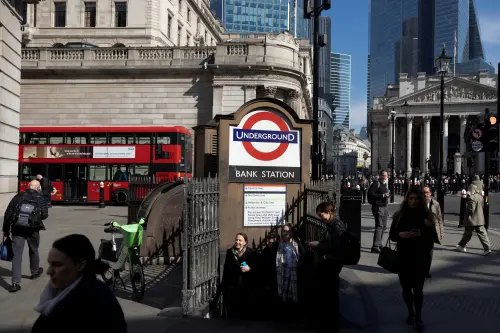The Bank of England cautioned against assumptions that interest rates will decrease in upcoming meetings, as policymakers navigate significant uncertainty affecting both the British and global economies.
The Monetary Policy Committee voted 8-1 to maintain current rates, with only external member Swati Dhingra advocating for a quarter-point cut. Economists had largely anticipated a 7-2 vote for unchanged rates.
The British pound initially recovered from an earlier decline but later fell to $1.2955, down 0.4% for the day and showing little variation from levels prior to the rate decision. Meanwhile, London's blue-chip FTSE stock index extended its decline, trading 0.3% lower.
In the bond market, the rate-sensitive two-year gilt yield dropped 3.3 basis points to 4.17%, down from 4.15% before the Bank's announcement.
Jessica Hinds, Director in Fitch Ratings’ Economics Team, remarked that the decision to hold rates was expected, and the strong majority vote confirmed this. Hinds noted that both the minutes and comments from Andrew Bailey imply that the MPC plans to further cut rates this year, potentially three times, with the next move in May. She emphasized that wage growth will be pivotal for future decisions, with Committee members likely waiting to see declines in wage growth before easing monetary policy.
Dean Turner, Chief Euro Zone Economist at UBS Global Wealth Management, pointed out that the Bank of England's decision to hold rates steady, with the 8-1 vote split being slightly more hawkish than anticipated, aligns with expectations. He highlighted the ongoing policy uncertainty, particularly concerning global trade, and mentioned that the upcoming Spring Statement might announce spending cuts that could negatively impact the economy.
Jeremy Batstone-Carr, Strategist at Raymond James Investment Services, noted that given the significant uncertainty surrounding the UK economy, rate-setters chose to proceed cautiously. He acknowledged the dual pressures on the Bank to stimulate the economy while maintaining a sufficiently restrictive base rate to control inflation, suggesting that future rate cuts aren't necessarily ruled out.
Yael Selfin, Chief Economist at KPMG UK, saw the decision to maintain unchanged rates as sensible amidst rising domestic uncertainty and an absence of updated forecasts since February. Selfin expressed concerns over external developments that heighten the uncertain outlook, including potential tariffs and their impact on inflation. However, she observed a clear easing bias in the meeting minutes and predicted that the Bank could start cutting rates again at the May meeting.
Zara Nokes, Global Market Analyst at JPMorgan Asset Management, described the Bank of England as caught between rising inflationary pressures and a weak growth outlook. While a rate cut might have been tempting, the decision to hold was deemed appropriate. Nokes stressed that current inflation dynamics and wage growth trends warrant a cautious approach, given the potential risks of basing decisions on softer survey data.
Lindsay James, Investment Strategist at Quilter, highlighted the prevailing uncertainty and upward shifts in inflation expectations, indicating that the Bank's decision was somewhat beyond its control. Despite a decline in energy prices, uncertainties surrounding tariffs remain, posing risks of further inflation. Market expectations currently suggest about two rate cuts for the year, reflecting simultaneous predictions for the U.S., as the Bank of England seeks to avoid hasty cuts that could exacerbate inflation.
Michael Field, Chief Equity Strategist at Morningstar, supported the slow and steady approach to rate cuts in light of inflation threats and tariff concerns. With rates already down 75 basis points from their peak, Field noted the Bank's intent to lower rates further, a strategy positively received by equity investors, particularly given the FTSE's proximity to all-time highs. He expressed optimism for equity market opportunities in the UK, anticipating that forthcoming interest rate cuts could foster a more supportive economic environment for consumers and businesses.
